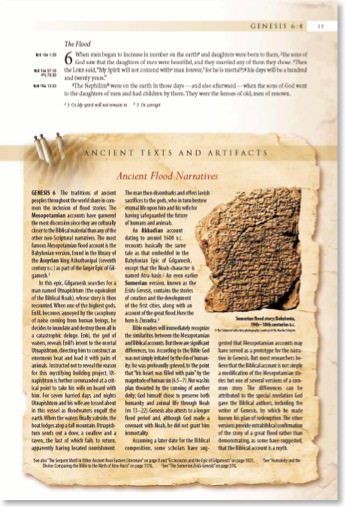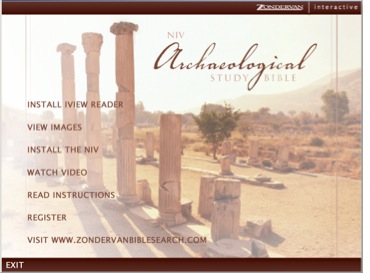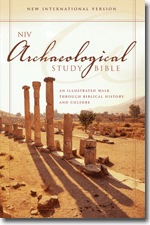The NIV Archaeological Study Bible: A Review
I served for five years as a chaplain and Bible teacher at a Christian high school. Whenever I got new groups of students, I always had to explain to them that our study of the Bible was not going to be like a Sunday School class where they showed up and heard nice stories. I informed them that our studies would be rooted in the surrounding history of the Bible because God's Word wasn't written separate from the culture where it originated. I especially liked it when I got comments such as "Hey, we've studied this in World Civ, too!" I've always felt it was important to connect the Bible to the history that surrounded it.
One of my graduating seniors, who had taken my classes for a couple of years, remarked, "Mr. Mansfield, I bet if a three-year-old was sitting in your lap and asked you why the sky was blue you would say to him, 'Well, first you have to understand the meaning of "sky" and "blue" from the viewpoint of ancient Mesopotamians in relation to their religious and political backgrounds. Only then will you begin to understand....'" I took that as a compliment. And this is why I like the ASB. Don't tell anyone, but at some point over the years much of my interests in biblical studies has shifted from theological priorities to those of a historical nature. Perhaps this is because I came to recognize that many of the theological errors that have come from some interpreters over the centuries are rooted in historical misunderstandings of the context(s) in which the Bible was written. The ASB will go a long way in preventing such errors.
The ASB is essentially a project from Gordon-Conwell Theological Seminary and published by Zondervan. Walter Kaiser is listed in the colophon (p. 2307) as the executive editor, and Duane Garrett (now at the Southern Baptist Theological Seminary) as the general editor and in charge of theological review. From what I've overheard, the bulk of the ASB was done by Dr. Garrett. The "About this Bible" section (pp. xii-xiii) at the beginning of the ASB demonstrate the purpose and value of this work:
The NIV Archaeological Study Bible focuses on the historical, literary and cultural context of the Bible. This context includes the history of people and places populating its pages, daily life in various periods and under widely diverse circumstances during Biblical times, and ancient texts that illuminate the Bible and the archaeology of the Biblical world. In addition the articles in this Bible devote particular attention to challenges archaeologists and Biblical scholars face on the critical issue of the trustworthiness of Scripture.
...
Many modern Christians shun the study of the ancient world for fear that scholars will make them aware of troubling facts that will serve only to undermine their faith in the Bible. In reality a careful study of the world of the Bible enhances our confidence in its historical accuracy and in its distinctiveness as the Word of God.
...
Further, many well-intentioned Christian readers, although not fully committed to a postmodern way of thinking, tend to interpret the Bible strictly in terms of their own experiences and standards, without ever considering what a prophet or apostle was saying to the people of his own day. An awareness of the beliefs conflicts, history and habits of the people of Biblical times forces us to confront questions like, "What did Paul actually mean when he wrote these words to the Corinthian Church?"
The ASB is a wealth of historical, cultural, literary, and archaeological information about Bible times. First there are 8,000 notes running along the bottom of the page like any regular study BIble. Most of these are a subset of the notes--specifically the historical and cultural notes--that run in Zondervan's NIV, NASB and TNIV Study Bibles. I would assume there may be some additional notes as well, but I didn't perform an in-depth comparison with the older works. But the study notes aren't where the strength of this Bible lies. Of immense value is collection of 500 short articles which are organized along the subcategories of archaeological sites, cultural and historical notes, ancient peoples and lands, reliability of the Bible and ancient texts and artifacts.

The average study Bible is aimed at a popular audience, and it's value is usually in it being a one-stop reference source. The ASB seems to be a step above the average popular study Bible, but that does not mean that it would not be accessible to the average Christian. In my experience teaching adults, I've found that there's great truth in the fear of delving into historical backgrounds because of some risk of undermining one's faith. I remember teaching a Sunday School class once where I suggested as a means of strengthening their faith that they read some non-biblical religious texts. There was almost a unanimous refusal to even consider this suggestion because they were afraid that it might make them doubt their faith. The ASB is not afraid to confront these issues and in fact shows the value of doing so. There are articles in the ASB on non-Biblical creation myths and flood stories. The documentary hypothesis receives full article treatment. And yet all this is done from a conservative-evangelical perspective with the goal of strengthening the reader's faith in the reliability of the Scriptures.
For me, I have no doubt that I have most, if not all of the information found in the ASB elsewhere in my library. But nowhere do I have this kind of information in one place so tightly tied to the biblical text as it is here. In my teaching, the ASB is a great first stop in research--much like the value of an encyclopedia. But also like an encyclopedia, this is a work that I can cheerfully become lost in. The articles are addictive--and there are 500 of them! Reading one is often not enough. I turn a page or two and there's something else that strikes my interest and I read that in some kind of biblical ADD response.
A few weeks ago, I gave myself a Saturday afternoon to sit in a local Starbucks and just explore the ASB to my heart's content. Some of what I write below came from my notes taken on that day, and some comes from my experience using this Bible as a reference in other teaching settings.
One feature of the ASB that I didn't mention above is the "Ancient Voices" that are scattered in the margins throughout the work. These are readings from genre-similar writings of the culture. At first it can be a bit odd to see pagan writings alongside biblical passages, but once the reader gets beyond this, he or she will be reminded that our Scriptures were not written in a cultural vacuum. When I was teaching from Song of Solomon a few weeks ago, I came across this ancient little ditty on p. 1036:
I will lie down inside,
and then I will feign illness.
Then my neighbors will enter to see,
and then my sister will come with them.
She'll put the doctors to shame
for she (alone) will understand my illness.
I love the mischievous playfulness in those lines, very much like the lines of the writer of the Song of Songs. There is a note at Song 4:9 explaining that sister "is a common term of endearment in the love poetry of the Ancient Near East," but unfortunately this explanation is six pages away from these lines. No doubt the uninitiated modern reader may not understand the use of sister in these lines and in Song of Solomon without this explanation. For my purposes, though, I wanted to know the source of the "Ancient Voices" lines. The only thing listed with the above-quoted passage was "Papyrus Harris," which did not tell me much. One might think the "Ancient Voices" segments would be listed or indexed somewhere in the back of the Bible. However, I finally found the source listed in the acknowledgments on p. xix. Although I thought this placement odd, I was delighted to see that the collection source for "Ancient Voices" comes from The Context of Scripture, edited by William W. Hallo and K. Lawson Younger. I was first introduced to these books a few years back in doctoral seminars with Daniel I. Block who always insisted that we must read Scripture in conjunction with other ancient literature.
In the front of the ASB there is an introductory essay on "The History of the Holy Land" which traces development from pre-Israelite culture through the modern day. Although the five-page article is brief, it will serve as a good introduction for many readers to the ongoing volatile nature of this region and the peoples who have inhabited it over the centuries. And if any reader is disappointed by the brevity of this article, perhaps this can be offset by the fact that the introductory article is cross-referenced throughout to many of the 500 other articles in the ASB. The introductory article also introduces the readers to the ASB's use of words in bold. Any word in bold in any of the articles is defined in a glossary at the back of the Bible. Unfortunately this bold highlighting is not applied to any of the 8,000 study notes, and I also noted that sometimes words listed in the glossary were not always bolded in the articles.
The ABS, like any good Bible, includes maps in the back--14 in all. Unfortunately, none of them are remarkable in any way related specifically to the other contents in this Bible. In fact, I believe they are just the same maps Zondervan includes in most of their other Bibles these days. I would have been interested to see perhaps maps of current archaeological digs, significant archaeological discoveries, important locations in Jerusalem, and even one detailing the proximity of the various Qumran caves to one another.
The map of the Exodus in the back only shows the "traditional" route (which is likely incorrect) and none of the other suggested routes in spite of the fact that the ASB contains excellent articles on other suggested routes of the Exodus: the northern route theory (p. 108), the southern route theory (p. 109) and the Arabian route theory (p. 112). Unfortunately no in-text maps display these routes, so it is left to the reader to plot these out alone. Related to this issue is an article (p. 123) that acknowledges disagreement by scholars on the exact location of Mt. Sinai (the traditional site which is the home of St. Catherine's Monastery is probably not the actual location). But again there is no map depicting alternative locations either in the text of the article or in the back of the Bible.
I admit that during my afternoon exploring and taking notes on the ASB, I ran out of time. Kathy came to get me before I got too far out of the Old Testament. But there is excellent treatment of the New Testament as well. For instance, there are articles on the Synoptic Problem and "Q" (p. 1685), the legend from the Middle Ages about the Needle's Eye Gate (it's thankfully debunked; p. 1594), the Pontius Pilate inscription (p. 1714), the use of the Septuagint in the New Testament (p. 1995) and so much more. Anyone interested in Greek and Roman history will especially appreciate many of the cultural articles in the ASB New Testament.
There are two main resources missing from the ASB that I wish it had. As I mentioned, study Bibles are good starting points for research or even good tools for quick reference. I wish that the editors had chosen to include bibliographies beyond merely the sources for which permissions were received. And it's really a shame that the NIV, the base text of the ASB, does not include the apocryphal/deuterocanonical books. Although I do not personally view these books as authoritative Scripture, they are important witnesses to the intertestamental time period, and I would have liked to have seen them get the standard ASB treatment. However, to the credit of the ASB, the subject index lists half a dozen articles strictly on the apocrypha and the intertestamental period just under the word apocrypha.
And truth be told, I don't see how the ASB could be any bigger than it is without going to two volumes. At two and a half inches thick and over four and a half pounds, it is easily the largest non-family Bible I own. However, it actually has fewer pages than the TNIV Study Bible. My hunch is thicker paper had to be used to accommodate the use of full-color printing. I have the hardback edition of the ASB (see Amazon link below), but it also comes in a variety of leather editions.

Of course, my greatest complaint about the CD is predictable if you know me--it's only for Windows! Don't tell Zondervan, but I was able to view it in Parallels Desktop on my MacBook, but it's not the same as running it natively. I don't believe that making the CD-ROM cross-platform would have been all that difficult. The CD's interface uses Macromedia Flash which is cross-platform already. The NIV text could have been included with Accordance Bible software for the Mac since Zondervan already partners with Accordance on a number of products. Finally, the Mac OS already includes its own image viewer, iPhoto. A simple script could have been used to import all the ASB image files into iPhoto. And that's what I did myself. I imported all 128 images into iPhoto and I even directed my system screensaver to the images. I'm already getting compliments from my students at IWU who want to know how to get that screensaver with biblical locations and artifacts!
Finally, I must say something about errors in the ASB. One of my readers has commented elsewhere that a number factual/technical errors througout this Bible. He said that in examining 12 pages he found 20 errors (or was that 12 errors on 20 pages?). I've done a couple of different Google searches, and I cannot find any definitive list of errors in the ASB, although I am not doubting that some errors in a work this ambitious must surely exist. The most egregious (to borrow a word used by someone else I pointed this out to) error I can specifically point to is an upside down Rosetta Stone on p. 101. This kind of error is a bit embarrassing, and maybe we can blame that on the graphic layout person
I have not taken the time to sift through the pages of the ASB and run fact checks. But my experience with this Bible so far makes me very enthusiastic about the project. I'm supportive enough to use it myself (it already has a permanent place on the shelf above my desk), recommend it to others, and we're even planning to give a copy to my brother-in-law for Christmas because he loves history (hopefully he's not reading this). I, too, love history and truly appreciate the application of it to the Scriptures as found in the ASB. The ASB would also make a great standard Bible for use in introductory New Testament and Old Testament courses in colleges and even seminaries.
I'll be interested to see if Zondervan eventually releases the Archaeological Study Bible in other translations besides the NIV, which is now almost three decades old. I'd be keen on a copy in the TNIV, and if it were released in a wide-margin edition, too...well, then I'd really be set.
Related: Archaeological Study Bible Website










